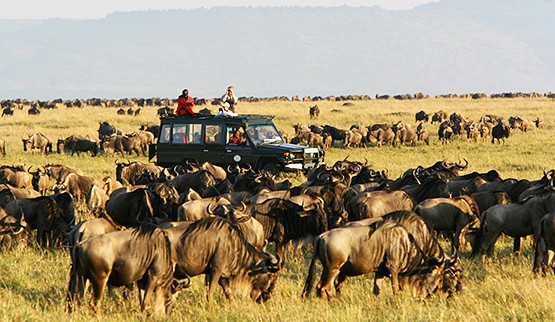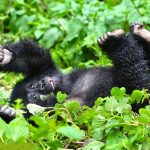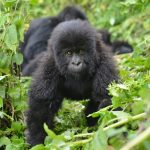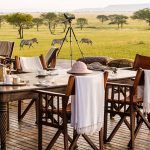Planning Eco Safaris in Kenya

Planning wildlife safaris in Kenya is superior, and one of our favorites for viewing incredible wildlife. If Africa had a Big Five for safari parks, the Masai Mara safari would easily make the final cut. The country is just so iconic when it comes to safaris, their Savannah parks and conservancies shelter just about every African species of charismatic mega-fauna form elephants, rhinos and millions strong herds of wildebeest to the predators that purse them.
Wildlife Safaris in Kenya
The Masai Mara National Reserve is definitely the main point of Kenya’s National Parks, no doubt about it. Few places on earth support such high concentrations of animals, and the Mara’s wildebeest spotted Savannah are undeniably the region’s star attraction.
Impressive at any time of the year it is at its best between July and September when around a million migrating wildebeest and thousands of topis, zebras and others pour into the reserve from Tanzania in search of the fresh grass generated by the rains. It is arguably, the most spectacular wildlife show on the planet and the one thing that no visitor to Kenya should even consider missing.
The Mara River
Pods of hippos can be found in any of the major rivers, with the largest and most permanent concentrations occurring in the Mara River. The river is also home to huge Nile crocodiles and is the scene where wildebeest make their fateful crossing during the migration.
The Central Plains
The southeast area of the park, bordered by the Mara and Sand Rivers is characterized by rolling grassland and low isolated hills. With the arrival of the migration, the herds of wildebeest and zebras all graze here. The riverine forests that border the Mara and Talek Rivers are great places to spot elephants, buffaloes and bush bucks. Leopards are sometimes seen near the Talek and Sand Rivers and around the Keekorok valleys.
Rhino Ridge and Paradise Plains
Rhino Ridge is a good area to see black-backed jackals as they are known to use the old termitaria here for den sites. Lookout Hill is worth a detour as it offers phenomenal views over the seasonal Olpunyaia Swamp. You may also get lucky and spot one of the few black rhinos that inhabit they inhabit the reserve anywhere between Lookout Hill and Rhino Ridge and in the vicinity of roan hill.
Besides, Masai Mara National Reserve, there is so much more to explore around the other National Parks. Their naturally beautiful landscapes are teeming with wildlife. You can also visit Amboseli National Park to view its signature attraction is the sight of hundreds of big-tusked elephants set against the backdrop of Africa’s best views of Mt Kilimanjaro.
Africa’s highest peak broods over the southern boundary of the park. Apart from guaranteed elephant sightings, you will also see wildebeest and zebras and you have a reasonable chance of spotting lions and hyenas. The park is also home to over 370 bird species.
Don’t out miss Samburu National Reserve’s unique species of well-known animals. Elephants are spotted below, hippos, and you are never too far from lions or leopards. But a safari in Samburu is more about going off the beaten track than ticking off a list of sights. Come to explore nature untamed and come to discover ancient tribal lifestyles.
How can I avoid the crowds?
The easiest way to avoid the crowds is to plan your Masai Mara safari to avoid the period when the migration is in full swing. If that’s not an option, it is almost impossible to shake off the convoys of safari vehicles that surround the Mara River crossings you might just have to grin and bear it if that’s why you’re here. That said, while all of those vehicles line up along the riverbank, much of the rest of the reserve can be surprisingly quiet.
Another option is to stay outside the reserve on one of the private or community conservancies that surround the Masai Mara National Reserve to the north and east. Some of these Mara North, Naboisho, Olare Orok and Olderikesi, in particular – have some of Africa’s highest population densities for Big Cats and, though expensive, are only accessible for those staying in one of the conservancy’s small lodges or tented camps. And if you’re staying here, you can always enter the reserve to see the migration, and then return to the relative quiet of the conservancy when you’ve had enough.”
A 4WD vehicle is always best, and it should usually be one with a reasonably high clearance. It’s even better if it has open sides (which most mid-range and top-end lodges and safari operators use) or a pop-up roof. Even so, the workhorse of many a Kenyan safari is the white minivan that has a pop-up roof – you stand on the seats and can see in all directions, which is ideal for taking photos.
Most of these minivans are 2WD vehicles and most have little difficulty in negotiating all but the more rugged Masai Mara trails; however, if you’re the one driving, remember that local drivers are experienced in these conditions and you’ll need to be cautious if driving a 2WD vehicle here, especially in the beginning.






0 Comments